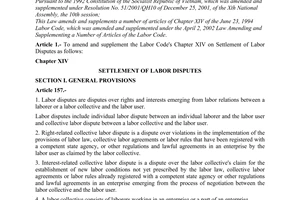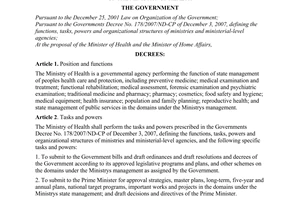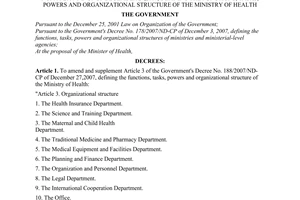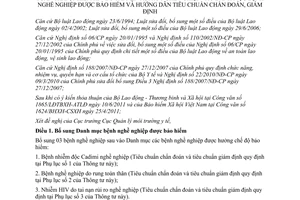Circular No. 42/2011/TT-BYT on the addition of occupational diseases resulting from Cadmium poisoning đã được thay thế bởi Circular 15/2016/TT-BYT regulations occupational diseases covered by social insurance và được áp dụng kể từ ngày 01/07/2016.
Nội dung toàn văn Circular No. 42/2011/TT-BYT on the addition of occupational diseases resulting from Cadmium poisoning
|
MINISTRY OF
HEALTH |
SOCIALIST
REPUBLIC OF VIETNAM |
|
No. 42/2011/TT-BYT |
Hanoi, November 30, 2011 |
CIRCULAR
ON THE ADDITION OF OCCUPATIONAL DISEASES RESULTING FROM CADMIUM POISONING, WHOLE-BODY VIBRATION, AND OCCUPATIONAL HIV INFECTION TO THE LIST OF INSURED OCCUPATIONAL DISEASES; GUIDANCE ON STANDARDIZED DIAGNOSIS AND EXAMINATION
Pursuant to the Labor Code dated June 23, 1994; the Law on the amendments to the Labor Code dated April 02, 2002; the Law on the amendments to the Labor Code dated June 29, 2006;
Pursuant to the Government's Decree No. 06/CP dated January 20, 1995 and the Government's Decree No. 110/2002/ND-CP dated December 27, 2002 on amendments to the Government's Decree No. 06/CP elaborating some Articles on occupational safety and occupational hygiene of the Labor Code;
Pursuant to the Government's Decree No. 188/2007/ND-CP dated December 27, 2007, defining the functions, tasks, powers and organizational structure of the Ministry of Health and the Government's Decree No. 22/2010/ND-CP dated March 09, 2010, amending and supplementing Article 3 of the Decree No. 118/2008/ND-CP;
After having the consent of the Ministry of Labor, War Invalids and Social Affairs in the Official Dispatch No. 1865/LDTBXH-ATLD dated June 10, 2011 and social insurance Agency in the Official Dispatch No. 1624/BHXH-CSXH dated April 25, 2011;
At the request of the Director of Health Environment Management Agency,
Article 1. Supplementing the List of insured occupational diseases
03 occupational diseases are added to the List of insured occupational diseases;
1. Occupational cadmium poisoning (Standardized diagnosis and assessment procedures are provided in Appendix 1 to this Circular);
2. Occupational disease resulting from whole-body vibration (Standardized diagnosis and assessment procedures are provided in Appendix 2 to this Circular);
3. Occupational HIV infection (Standardized diagnosis and assessment procedures are provided in Appendix 3 to this Circular).
Article 2. Benefits for sufferers of occupational diseases
The workers diagnosed as suffering from the occupational diseases mentioned in Article 1 of this Circular are entitled to the insurance policies specified in the Labor Code and its guiding legislative documents.
Article 3. Responsibility for the implementation
the Chief of the Ministry Office, the Chief Inspector of the Ministry, the Director of Health Environment Management Agency, the Heads of Departments and Agencies affiliated to the Ministry of Health, the Heads of units affiliated to the Ministry of Health, Directors of Services of Health, and heads of relevant units are responsible for the implementation of this Circular.
Article 4. Effect
This Circular takes effect on January 15, 2012.
Units are recommended to report the difficulties that arise during the implementation to the Ministry of Health (Health Environment Management Agency) for consideration and settlement./.
|
|
PP THE
MINISTER |
APPENDIX 1
STANDARD OF DIAGNOSIS AND EXAMINATION OF
OCCUPATIONAL CADMIUM POISONING
(promulgated together with the Circular No. 42/2011/TT-BYT dated
November 30, 2011 of the Ministry of Health)
I. SCOPE OF REGULATION
This Standard specifies the exposure factors, standardized diagnosis and assessment of impairment caused by occupational cadmium (Cd) poisoning applicable to the workers exposed to cadmium at work.
II. STANDARDIZED DIAGNOSIS
1. Exposure factors
a) Exposure to Cd in the air in the working environment which at a concentration higher than the permissible occupational hygiene standard: 0.01mg/m3 or over 0.05 mg/m3 or air (according to the Decision No. 3733/2002/QD-BYT dated October 10, 2002 of the Minister of Health).
b) Exposure period: ≥ 3 years.
c) Monitoring period: 3 years.
2. Clinical symptoms:
One of the clinical symptoms below:
a) Kidney injuries:
- Pain in the kidneys, painful urination, frequent urination;
- Cloudy urine or hematuria;
- Swelling.
b) Bone injuries:
- Pain in bones;
- Osteomalacia;
- Brittle bones.
c) Injuries of the respiratory tract:
- Rhinitis;
- Reduction, loss of olfaction;
- Symptoms of chronic pneumonia, bronchitis (coughing, dyspnea, sputum, chest pain, fever).
3. Paraclinical tests
a) The urine test result (within 24 hours) shows that:
- The Cd content in urine is ≥ 5 mg/l;
- Urinary Cd content ≥ 400 mg/l;
- Urinary protein content ≥ 80mg/l;
- Micro-albumin in the urine is ≥ 20 mg/l, or b2 - Microglobulin ≥ 1 mg/l.
b) Signs of osteoporosis are shown;
c) Other tests:
- Ultrasound testing: images of kidney injuries may be produced;
- Lung x-ray: images of lung injuries may be produced;
- Measurement of respiratory functions: pulmonary ventilation disorder is possible.
III. CLASSIFICATION OF SEVERITY
1. Suspicious: Urinary Cd ≥ 5 mg/l, no manifestation of urinary protein.
2. Mild form: signs of asthenia, some early signs of kidney injuries, bone injuries, and paraclinical indices depending on the severity of injuries. Urinary Cd content ≥ 5 mg/l.
3. Severe form: clinical signs of kidney dysfunction in combination with other injuries. Urinary protein content ≥ 80mg/l. Urinary micro-protein: Urinary micro-albumin ≥ 20 mg/l, or b2 - Microglobulin ≥ 1 mg/l.
IV. STANDARDIZED ASSESSMENT OF IMPAIRMENT
|
Level of impairment - Signs |
Rating (%) |
Monitoring period |
|
Level 1 (equivalent to the suspicious form in section III). - Urinary cadmium ≥ 5 µg/l/24 hours; - Negative urinary protein. |
5 – 9
|
1 year |
|
Level 2 (equivalent to the mild form in section III). 2.1. Testing: + Urinary cadmium ≥ 5 µg/l/24 hours; + Negative urinary protein. Clinical symptoms: rhinitis relapse, unilateral olfactory loss 2.2. Test as 2.1 Clinical symptoms: rhinitis relapse, bilateral olfactory loss 2.3. Test as 2.1 Clinical symptoms: asthenia (emaciation, mild anaemia) |
16 – 20
21 – 25 |
|
|
Level 3 (equivalent to the severe form in section III). Testing: + Urinary cadmium ≥ 5 µg/l/24 hours; + Urinary cadmium ≥ 80 µg/l/24 hours; + Urinary Micro-protein: (urinary Micro-albumin ≥ 20mg/l/24 hours and/or b2 - Globulin ≥ 1mg/l/24 hours) Kidney dysfunction - renal calculus. |
|
1 year |
|
In particular: 3.1. Chronic kidney inflammation: - Responsive to treatment (stably treated with medicines) - Frequently recurring (the disease recurs twice or more after being treated with medicines); - Kidney failure complications (similar to the rating of kidney failure) |
21 – 25 41 – 45
|
|
|
3.2. Urinary calculi: 3.2.1. No intervention, no glomerular filtration dysfunction found 3.2.1.1. Unilateral. 3.2.1.2. Bilateral. 3.2.2. No intervention, glomerular filtration dysfunction found: 3.2.2.1. Unilateral. 3.2.2.2. Bilateral. 3.2.3. Calculi are removed, good results: 3.2.3.1. Unilateral. 3.2.3.2. Bilateral. 3.2.4. Intervention is made to remove calculi, bad results with complications. 3.2.4.1. Unilateral. 3.2.4.2. Bilateral. |
5 – 9 21
31 – 35 41 – 45
15 – 20 21 – 25
41 – 45 51 – 55 |
|
|
3.3. Kidney failure 3.3.1. Stage I.
3.3.2. Stage II. 3.3.3. Stage IIIa 3.3.4. Stage IIIb and stage IV (replacing the broken kidney: hemodialysis, peritoneal filtration, renal transplantation). |
41- 45 (temporary) 61 – 63 71 – 73 91 |
|
|
* If symptoms of osteoporosis is present, 5% - 10% shall be added to the rating using the declining method (only applicable to males < 55 years old and females < 50 years old) * Apply the declining method to rate bone fracture if bone fracture complications occur. |
||
APPENDIX 2
STANDARD OF DIAGNOSIS AND ASSESSMENT OF
OCCUPATIONAL DISEASES DUE TO WHOLE-BODY VIBRATION
(Promulgated together with the Circular No. 42/2011/TT-BYT dated
November 30, 2011 of the Ministry of Health)
I. SCOPE OF REGULATION
This Standard specifies the exposure factors, standardized diagnosis and assessment of impairment caused by occupational diseases resulting from whole-body vibration applicable to workers exposed to low-frequency vibration at work.
II. STANDARDIZED DIAGNOSIS
1. Exposure factors
a) Exposure to vibration beyond the permissible standards in terms of acceleration and velocity (according to TCVN 5127-90).
b) Exposure period: ≥ 5 years.
c) Monitoring period: 1 year.
2. Clinical symptoms:
a) Whole-body prostration, headache, insomnia, nausea, neurovegetative disorder.
b) Low back pain:
- Level of pain: very painful (discomfort in the lower back area, restricted movements, help is required);
- Frequency of lower back pain: more than 5 times/year;
- Leave period due to lower back pain: 15 days or more in a year.
c) Front chest pain, right lower quadrant pain.
d) Signs of stomach, duodenum disorders: belching, heartburn, dyspepsia, epigastric pain, may have a history of gastrointestinal bleeding.
dd) Signs of urinary disorders: painful urination, frequent urination, urinary retention, cloudy, reddish urine.
e) Result of SchÖber’s test (measuring lumbar spine flexion): Positive when lumbar spine flexion ≤ 3 cm.
g) Signs of Lasègue: have the patient lie on his back, knee straight; lift the legs until pain is felt. The test is positive is the angle between the leg and the bed is ≤ 80 degrees.
h) Valleix’s pain point test: positive (determining pain points along sciatic nerve)
3. Paraclinical testing
a) Possible X-ray images of lumbar vertebrae (front and side): concave vertebrae, vertebral fracture, and spinal disc deformation.
* Notes: eliminate the congenital impairments, injuries, or diseases resulting from other causes.
b) Other tests:
- Gastroscopy: possibility of gastric, duodenal ulcer
- Gastric imaging: possibility of gastroptosis;
- Abdominal ultrasound: eliminate the diseases that cause right lower quadrant pain.
III. STANDARDIZED ASSESSMENT OF IMPAIRMENT
|
Level of impairment - Signs |
Rating (%) |
Monitoring period |
|
1. Lower back pain 1.1. Level 1: a) Very painful (discomfort in the lower back area, restricted movements, help is required); b) Recurring 5 times in a year. c) The worker takes averagely 15 days off in a year. d) SchÖber’s test is positive is positive and ≤ 3 cm. |
11 – 15 |
1 year |
|
1.2. Level 2 a) Immobilizing pain (which causes the patient to avoid moving the body, sciatic nerve pain) or extreme pain (even when lying still). b) Constantly recurring. c) The worker takes averagely 30 days off in a year. d) SchÖber’s test is positive is positive and ≤ 3 cm. |
16 - 20 |
1 year |
|
2. Images of injured centrums in the lumbar vertebrae L2: degenerated, concave, trapezoidal centrums, or centrum fracture. (Male < 55; Female < 50.) |
21 - 25 |
1 year |
|
* Notes: eliminate the diseases, malformations, spinal injuries (according to the medical record). |
||
APPENDIX 3
STANDARD OF DIAGNOSIS AND ASSESSMENT OF
OCCUPATIONAL HIV INFECTION
(promulgated together with the Circular No.
42/2011/TT-BYT dated November 30, 2011 of the Ministry of Health)
I. SCOPE OF REGULATION
This Standard specifies the exposure factors, standardized diagnosis and assessment of bodily injuries due to occupational HIV infection applicable to the workers exposed to HIV at work.
II. STANDARDIZED DIAGNOSIS
1. Exposure factors
- Biological fluid, blood of HIV carriers on damage skin or mucous membrane.
- A Certificate of Occupational Exposure to HIV and the Certificate of Occupational HIV infection according to current regulations (currently the Prime Minister’s Decision No. 120/2008/QD-TTg dated August 29, 2008 on identification of people occupationally exposed to HIV and infected with HIV).
- Exposure time: once or more.
- Latest diagnosis: six months after the damage skin or mucous membrane is in contact with biological fluid, blood of HIV carriers.
2. Clinical symptoms:
With or without the manifestations of immunodeficiency syndrome and opportunistic infections (tuberculosis, pneumonia, prolonged fever, digestive disorders, etc.)
3. Paraclinical testing
HIV test result is given in accordance with current regulations of the Ministry of Health (currently the Decision No. 3003/QD-BYT dated August 19, 2009 of the Ministry of Health).
- The HIV test after the occupational accident is negative (-).
- The HIV test of the person exposed to HIV 01 month or 03 months or 06 months after the occupational accident is positive (+).
III. CLASSIFICATION OF CLINICAL STAGES AND IMMUNITY STAGES OF OCCUPATIONAL HIV INFECTION
3.1. Clinical stages of occupational HIV infection
1st clinical stage: no symptoms
- No symptoms;
- Prolonged whole-body swollen lymph nodes.
2nd clinical stage: mild symptoms
- Unexplained slight weight loss (<10% if body weight);
- Recurrent respiratory infections (sinusitis, tonsillitis, otitis media, pharyngitis)
- Zona (Herpes zoster);
- Thrush;
- Recurrent mouth ulcer;
- Urticaria, itch;
- Seborrhoeic dermatitis;
- Fungal nail infection.
3rd clinical stage: progressive symptoms
- Unexplained dramatic weight loss (>10% if body weight);
- Unexplained diarrhoea that lasts for more than 01 month;
- Unexplained intermittent or continuous fever that lasts for more than 01 month;
- Recurrent oral candidiasis;
- Oral leukoplakia;
- Phthisis;
- Severe infections (pneumonia, empyema, purulent arthritis, bone and joint infection, meningitis, septicemia);
- Acute necrotic mouth ulcer, gingivitis or periodontitis;
- Anaemia (Hb< 80g/L), mild leukopenia (< 0.5x109/L) and/or chronic leukopenia (< 50x109/L).
4th clinical stage: severe symptoms
- HIV wasting syndrome (>10% if body weight, fever or diarrhoea that lasts for more than 1 months);
- Pneumocystis jiroveci pneumonia (PCP);
- Chronic Herpes simplex infection (in the lips, mouth, genitals, around the anus or any organ);
- Candidiasis Of The Esophagus (or trachea, bronchial tubes, lungs)
- Extrapulmonary tuberculosis;
- Sarcoma Kaposi;
- Diseases caused by Cytomegalovirus in the retina or other organs;
- Diseases caused by Toxoplasma in the central nervous system;
- Brain diseases resulting from HIV;
- Extrapulmonary cryptococcosis including meningitis;
- Disseminated Mycobacteria avium complex diseases;
- Progressive multifocal leukoencephalopathy -PML
- Chronic diarrhoea caused by Cryptosporidia;
- Chronic diarrhoea caused by Isospora;
- Diseases caused by disseminated fungi (Penicillium, extrapulmonary Histoplasma)
- Recurrent blood infection (including Sallmonella infection other than typhoid)
- Lymphoma of the brain or non-Hodgkin lymphoma B cell;
- Invasive cervical cancer (carcinoma);
- Atypical disseminated leishmaniasis due to leishmania;
- Kidney diseases caused by HIV;
- Myocarditis caused by HIV.
3.2. Classification of stages of immunity deficiency caused by occupational HIV infection
|
Degree |
Number of CD4 per mm3 |
|
Normal immunity or unremarkable deficiency of immunity |
> 500 cells/mm3 |
|
Slight immunity deficiency |
350 – 499 cells/mm3 |
|
Progressing immunity deficiency |
200 – 349 cells/mm3 |
|
Severe immunity deficiency |
< 200 cells/mm3 |
IV. STANDARDIZE BODILY INJURY ASSESSMENT
|
Level of injury |
Rating (%) |
Monitoring period |
|
Stage 1 (level A) ≥ 500 T-CD4 cells/mm3 |
31 – 35 |
3 months |
|
350 ≤ T-CD4 cells/mm3 < 499 |
41 – 45 |
|
|
Stage 2 (level B) 200 ≤ T-CD4 cells/mm3 < 349 |
51 – 55 |
3 months |
|
Stage 3 (level C) 100 ≤ T-CD4 cells/mm3 < 199 |
61 - 63 |
3 months |
|
Stage 4 (level D) < 500 T-CD4 cells/mm3 |
71 - 73 |
3 months |
|
Notes: if organs are damaged by complications, corresponding rating shall be added (according to the current Impairment table) |
||
------------------------------------------------------------------------------------------------------
This translation is made by LawSoft and
for reference purposes only. Its copyright is owned by LawSoft
and protected under Clause 2, Article 14 of the Law on Intellectual Property.Your comments are always welcomed









